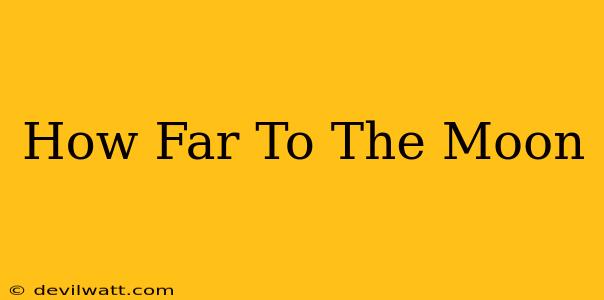The moon. Our celestial neighbor, a silent witness to Earth's history, and a constant source of wonder and inspiration. But how far away is it, really? It's a question that's captivated humanity for centuries, driving exploration and pushing the boundaries of our understanding. This post delves into the distance to the moon, exploring the different ways we measure it and the fascinating implications of that distance.
Understanding the Ever-Shifting Distance
The distance to the moon isn't a fixed number. Because the moon's orbit isn't perfectly circular, but rather elliptical, its distance from Earth constantly changes.
Perigee and Apogee: The extremes of lunar distance
- Perigee: This is the point in the moon's orbit where it's closest to Earth. At perigee, the moon can be as close as approximately 225,623 miles (363,104 kilometers) away.
- Apogee: This is the point in the moon's orbit where it's farthest from Earth. At apogee, the distance can stretch to around 252,088 miles (405,696 kilometers).
This means the distance varies by roughly 26,465 miles (42,592 kilometers) throughout the moon's orbit!
Average Distance: A Useful Metric
While the distance fluctuates, scientists often use an average distance for calculations and general understanding. This average distance is approximately 238,855 miles (384,400 kilometers). This figure provides a useful benchmark for understanding the vast scale involved.
Measuring the Moon's Distance: A Historical Perspective
Determining the moon's distance has been a challenge throughout history. Early attempts involved ingenious methods, often relying on geometry and observation. Over time, technology has provided increasingly accurate measurements.
Early Methods: Triangulation and Eclipses
Early astronomers used methods like triangulation – measuring angles from different locations on Earth to pinpoint the moon's position – to estimate the distance. Observations of lunar eclipses also provided valuable data.
Modern Methods: Laser Ranging and Radio Waves
Today, we use far more precise techniques. Lunar Laser Ranging (LLR) involves bouncing lasers off reflectors placed on the moon during the Apollo missions. By measuring the time it takes for the light to return, scientists can calculate the distance with incredible accuracy. Radio waves are also used for similar measurements.
The Implications of Lunar Distance
The distance to the moon has profound implications for various aspects of our lives and scientific endeavors:
- Tides: The gravitational pull of the moon, influenced by its distance, is a major factor in Earth's tides. Variations in lunar distance subtly affect the strength of tides.
- Space Exploration: The distance presents a significant challenge for space travel. The energy required to reach the moon and return is substantial, influencing mission design and planning.
- Scientific Research: Precise measurements of the moon's distance help scientists study its orbital mechanics, gravitational interactions with Earth, and the broader dynamics of our solar system.
Conclusion: More Than Just a Number
The distance to the moon, while seemingly just a numerical value, represents a rich history of scientific inquiry, technological advancement, and human ambition. From early estimations to modern laser ranging, our understanding of this distance has continually evolved. This journey of discovery highlights not only the vastness of space but also the remarkable capabilities of human ingenuity. The next time you look up at the moon, remember the incredible distance it spans, and the fascinating science behind determining just how far away it truly is.

